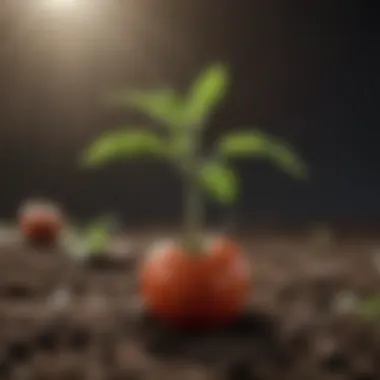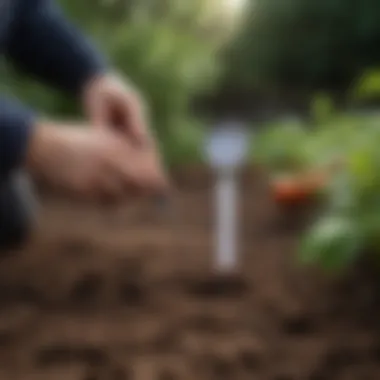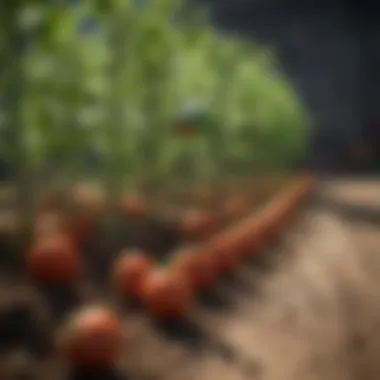Optimal Timing for Planting Tomato Seeds Explained


Intro
Planting tomato seeds requires careful consideration of timing. This is critical for ensuring optimal growth and a bountiful harvest. Understanding the climate, soil conditions, and the specific variety of tomato you are planting can greatly impact the success of your gardening efforts. Various factors can influence when to plant, such as frost dates, soil temperatures, and the overall growing season in your region.
As we delve into this topic, we will explore the ideal conditions for germination, the importance of planting at the right time, and guidelines tailored for different regions. This guide will help both new and seasoned gardeners make informed decisions about when to plant their seeds, ensuring healthy plants and fruitful outcomes.
Key Insights and Trends
Understanding Frost Dates
One of the most important factors in timing your tomato planting is the frost date. Understanding the last frost date in your area can set the stage for when it is safe to plant. Typically, tomatoes should be planted after the last frost has passed. This date can vary significantly depending on your geographical location.
You can find frost date information from local agricultural extensions or via gardening websites. Here are some general frost considerations:
- Early spring frost can damage young plants.
- Late spring frosts can stunt growth.
- Using tools like frost blankets can help protect seedlings.
"Knowing your region's frost dates is essential to successful tomato gardening."
Soil Temperature Considerations
Soil temperatures must also be monitored. Tomatoes thrive when soil temperatures are between 60°F and 85°F. Planting seedlings into cold soil can lead to poor development or even plant death. Utilize a soil thermometer to measure the ground temperature several days before planting.
Regional Growing Conditions
Each region has its own unique characteristics that affect tomato cultivation.
- Northern climates may need to start seeds indoors 6 to 8 weeks before the growing season.
- Southern climates allow for direct sowing of seeds earlier in the season.
- Humid areas need to manage watering closely to prevent rot.
Awareness of these conditions can assist in determining the optimal timing for planting.
Practical Tips and How-To Guides
Step-by-Step Guidelines for Planting Tomato Seeds
- Choose the Right Variety: Select tomato varieties that are suitable for your climate. Consider options like Early Girl for cooler climates or San Marzano for warmer areas.
- Prepare Seedlings: Start seeds indoors using seed trays filled with seed starting mix. Ensure they have adequate light and moisture.
- Transplanting Timing: Transplant seedlings outdoors after hardening them off, typically one week after the last frost date.
- Monitor Conditions: Keep an eye on both soil temperature and local weather forecasts.
- Water Strategically: Water seedlings adequately, especially in high heat, but avoid waterlogging.
These guidelines reinforce the significance of timing in plant health and productivity.
General Best Practices
It is advisable to keep additional tips in mind:
- Use raised beds to improve drainage.
- Employ mulching techniques to regulate soil temperature.
- Regularly check for pests to protect young plants.
By following these insights and strategies, you position yourself for a successful tomato growing season.
Intro to Tomato Cultivation
Tomato cultivation represents a significant sector in gardening and agriculture. The conscientious cultivation of tomatoes can yield successful results, enhancing both your garden’s aesthetic and its productivity. This introduction serves as a platform to understanding why timing is essential in the tomato planting process. Knowing the right moment to plant ensures optimal growth, fruiting, and resistance to pests and diseases.
Familiarity with varieties of tomatoes is also paramount. Tomatoes come in diverse shapes, sizes, and flavors, each requiring different care conditions. Some varieties thrive in cooler weather while others need warmth to produce fully. Being mindful of these factors can lead to more fruitful growing experiences.
Working towards mastering timing in planting can create benefits such as increased yields, healthier plants, and more robust flavors. Whether you are an enthusiastic beginner or a seasoned gardener, mastering the elements of tomato cultivation can bring satisfaction and success to your gardening efforts.


Understanding Tomato Varieties
Tomato varieties vary significantly in growth habits, flavors, and optimal growing conditions. Determining the right variety is one of the first steps in successful cultivation. Common varieties include determinate types, which generally grow to a certain height and produce fruit all at once, and indeterminate types that continue to grow and produce fruit throughout the season.
When choosing a variety, consider local growing conditions and tastes. For instance, cherry tomatoes are sweet and often sought after for snacking, while beefsteak tomatoes are favored for their size and juiciness in cooking. Varieties like Roma tomatoes are ideal for sauces due to their lower moisture content. Knowing what you want and what your conditions allow is instrumental in making a choice.
The Importance of Timing in Planting
Timing in the planting of tomatoes cannot be overstated. It significantly influences the health of your plants and the quality of the tomatoes produced. Planting too early before the last frost can lead to damage or failure of seedlings due to unexpected cold temperatures. Conversely, delaying planting too long may shorten the growing season, leading to a reduced harvest.
Proper timing ensures healthy growth and abundant yields.
For optimal results, monitor local frost dates, as they vary by region. Many gardeners find it helpful to start seeds indoors six to eight weeks before these dates, allowing for early growth while taking care to avoid frost. Furthermore, understanding the soil temperature at the time of transplanting can influence plant vitality; tomatoes thrive when soil temperatures reach a consistent 60°F to 70°F.
In summary, engaging effectively with the understanding of tomato varieties and the importance of planting timing is key to successful cultivation. Proper planning and attention to these details can transform a simple gardening effort into a flourishing yield.
Factors Influencing Planting Time
Understanding the precise timing of planting tomato seeds is crucial for successful cultivation. This section delves into significant factors that influence the planting time. These elements are not only about ensuring good growth but also about optimizing yields. Climate conditions play a vital role, as well as local variances which can significantly shift the ideal planting schedule. By comprehending these aspects, gardeners can make informed decisions and thus achieve a bountiful harvest.
Frost Dates and Their Significance
Frost dates are pivotal in determining the safety of planting tomato seeds. The first and last frost dates mark the boundaries within which gardeners must operate. This schedule varies widely depending on geographic location.
Planting too early can expose seedlings to frost, causing stunted growth or even complete die-off. By knowing the local frost dates, gardeners can calculate a safe window for seed planting. For instance, if the last frost date is May 15, planting should typically occur two weeks after this date. This ensures that the young plants have enough warmth to thrive and avoid frost exposure.
In summary, understanding frost dates is an essential component. It allows for effective planning, enabling fruits to grow optimally.
Soil Temperature Requirements
Soil temperature is also crucial when planting tomato seeds. Different plants have specific temperature requirements for germination. For tomatoes, soil should ideally be around 60°F (15°C) to 70°F (21°C).
Cooler soil inhibits germination, leading to weakened plants. Conversely, excessively warm soil can harm seedlings. To check soil temperature, use a soil thermometer. If the soil is not warm enough, it may be beneficial to delay planting or consider strategies such as using black plastic to warm the soil.
Thus, soil temperature directly impacts seed germination and future plant health.
Climate Zones and Regional Variations
Different climate zones influence the best time to plant tomato seeds. For example, subtropical regions may allow for earlier planting when compared to temperate zones. Each zone has its unique characteristics, affecting everything from temperature to moisture.
This regularity of climatic conditions impacts plant growth. In areas known for prolonged winters, it is better to plant seeds indoors and transplant them once the weather is suitable for growth.
A gardener in a cooler climate should often avoid early planting. Conversely, those in warmer areas may take advantage of longer growing seasons. Consequently, knowing one's climate zone helps inform critical decisions about planting times and methods.
Understanding these factors leads to better gardening outcomes. Proper timing can mean the difference between a mediocre yield and an abundant harvest.
The Germination Process
The germination process plays a pivotal role in the successful cultivation of tomatoes. This phase marks the transition from seed to seedling, establishing the foundation for plant health and productivity. Understanding the elements that contribute to effective germination can lead to robust plants capable of yielding abundant harvests. Key factors such as moisture, temperature, and light must be closely monitored to create an environment that encourages sprouting. A well-managed germination process increases the likelihood of thriving tomato plants, ensuring the gardener's efforts do not go to waste.
Optimal Conditions for Germination
For tomato seeds to germinate successfully, it is essential to provide optimal conditions. Here are crucial factors that influence this process:


- Temperature: Tomato seeds thrive in warm conditions. The ideal soil temperature ranges from 70°F to 80°F (21°C to 27°C). Lower temperatures can delay germination, while excessively high temperatures can damage the seeds.
- Moisture: The seeds require consistent moisture without being waterlogged. A well-draining seed-starting mix is vital. Lightly misting the soil can help maintain required moisture levels.
- Light: Once the seeds have sprouted, they need sufficient light for healthy growth. A lack of light can lead to leggy seedlings that are weak and unable to develop properly.
By fulfilling these conditions, gardeners will aid nature's course, leading to successful germination.
How to Start Seeds Indoors
Starting tomato seeds indoors allows for an early growing season, especially in regions with shorter summers. Here’s a step-by-step guide to doing this:
- Containers: Select seed trays or small pots. Ensure proper drainage to avoid root rot.
- Soil: Use a sterile, seed-starting mix to minimize pathogen risks.
- Planting Seeds: Sow seeds about 1/4 inch deep. Space them according to seed variety instructions.
- Watering: Water gently to moisten the soil. Be careful not to wash away seeds.
- Covering: Cover containers with a plastic dome or plastic wrap to maintain humidity until germination occurs.
- Temperature: Place containers in a warm location or use a heat mat to keep temperature consistent.
By following these steps, you can initiate the germination process effectively indoors.
Signs of Successful Germination
Successful germination is indicated by various signs. These include:
- Sprouting: Small shoots emerging from the soil surface is the first clear sign.
- Leaves: The development of true leaves beyond the initial seed leaves (cotyledons) shows that the plant is growing well.
- Healthy Color: Bright green leaves indicate strong seedlings, while yellowing may suggest issues.
- Strong Stems: Sturdy, upright stems are a good indication of proper light and nutrient conditions.
Recognizing these signs helps gardeners assess the health of their tomato seedlings and make necessary adjustments to their care routine.
Transplanting Seedlings
Transplanting seedlings is a crucial step in the process of growing tomatoes. This phase occurs after the germination period, which involves the transition of young plants from small containers or seed trays to the larger garden bed or a new pot. The timing of this step can significantly influence the overall health and productivity of the plants. Proper transplanting ensures that seedlings adapt to outdoor conditions efficiently.
The importance of transplanting seedlings cannot be overstated. It allows plants more space to grow, access to better soil nutrients, and exposure to sunlight necessary for photosynthesis. Additionally, transplanting helps in hardening off the seedlings. This hardening off process is where young plants gradually acclimate to the outdoor environment, preventing shock and promoting robust growth.
When to Transplant Seedlings Outdoors
Transplanting seedlings outdoors should be timed carefully. The optimal period for this activity typically happens after the last frost date in your area. This ensures that the young plants do not encounter unexpected cold spells that could damage them.
Generally, transplanting takes place when seedlings are about six to eight weeks old and have developed a strong set of true leaves. It is essential to monitor soil temperatures, as tomatoes prefer soil temperatures to be at least 60°F (16°C) for effective growth. If local conditions allow, the time for transplanting can extend from mid-spring to early summer, depending on regional climates.
Preparing Seedlings for Transplanting
Before transplanting, proper preparation of seedlings is vital. It begins with hardening off the seedlings for about a week. This process involves placing the seedlings outdoors in a shaded area for a few hours each day, gradually increasing their exposure to direct sunlight and outdoor conditions.
Other steps include:
- Ensuring that the seedlings are well-watered the day before transplanting.
- Checking root development; healthy seedlings should have roots that slightly fill the container.
- Avoiding any signs of disease or pests on the seedlings prior to transplanting.
These preparatory measures help reduce stress during the transplanting process, contributing to a healthier growth post-transplant.
Transplanting Techniques
Adopting proper transplanting techniques can optimize the success of your tomato plants. Here are a few best practices:
- Select a cloudy day for transplanting. This minimizes sunlight stress on the seedlings.
- Prepare the planting holes before removing the seedlings from their containers. The holes should be deep enough to accommodate the root ball but not so deep that it inhibits growth.
- Handle seedlings gently during the transition. Avoid touching the stems, as they are more delicate.
- Plant at the same depth as they were in the containers to avoid burying the stem, which can lead to rot.
- Water the seedlings lightly right after transplanting to help settle the soil around the roots.
Adhering to these techniques will facilitate a smoother transition for your tomato seedlings and contribute to their overall growth and yield.
"Transplanting is a vital process that can significantly influence your tomato yield. Care in timing and technique cannot be underestimated."
By following these guidelines, gardeners can ensure their seedlings thrive once transplanted, ultimately leading to a fruitful tomato harvest.


Seasonal Considerations
Understanding seasonal considerations is vital for successfully planting tomato seeds. The timing of planting not only impacts the growth rate of tomato plants but also determines the overall yield. Different seasons offer unique advantages and challenges. By grasping these seasonal factors, gardeners can maximize their tomato production while adapting to local climates and conditions.
Spring Planting Strategies
Spring is often viewed as the ideal time for planting tomato seeds. As temperatures begin to rise and days get longer, the conditions become favorable for growth. Before starting planting, it is crucial to observe local frost dates. Ignoring the possibility of a late frost can damage young plants, making it essential to plant after the last frost has passed.
- Choose the Right Variety: When selecting tomato varieties, consider those that thrive in your climate zone. Early maturing varieties can produce ripe fruits sooner, which is ideal for spring planting.
- Seed Starting Indoors: Consider starting seeds indoors six to eight weeks before the last frost date. This allows for strong seedlings that are ready to go outside when the conditions are favorable. Use seed trays and keep them under grow lights to ensure adequate light exposure.
- Gradual Acclimatization: Before transplanting, acclimate seedlings to the outdoor environment, a process known as hardening off. Gradually expose them to outdoor conditions over a week or so. This reduces shock and increases chances of survival.
The right preparation and timing in spring will ensure that tomato plants establish themselves and are capable of flourishing in the burgeoning warmth of the season.
Fall Planting for Extended Harvests
Planting tomatoes in the fall may seem unconventional but can indeed extend the harvest season. This strategy relies heavily on selecting the right environment and conditions. Home gardeners focusing on fall planting should consider the following:
- Season-Extending Techniques: Utilizing cloches or row covers can help protect plants from cool temperatures while retaining warmth. Any protective coverage will allow for a longer growing season and can delay the onset of frost damage.
- Late Varietals: Choose tomato varieties specifically bred for late-season growth. These varieties will be better suited to ripening in the cooler temperatures of early fall.
- Soil Preparation: Ensure that the soil remains warm enough for seed germination. Conduct soil tests ahead of time to ascertain the warmth and nutritional content of the soil before planting.
"Planting in fall can yield surprising results. With the right approach, gardeners can enjoy fresh tomatoes well into the late autumn months."
Pest and Disease Management
Pest and disease management is a crucial aspect of tomato cultivation. The presence of pests and diseases can significantly hinder growth, yield, and overall plant health. Identifying potential threats early allows gardeners to take proactive measures. This section emphasizes the importance of staying informed about common pests and implementing preventative strategies to ensure healthy growth. Maintaining the vitality of your tomato plants establishes a more fruitful gardening experience.
Common Pests Affecting Tomato Plants
Tomato plants are susceptible to various pests. An understanding of these insects can help you protect your plants. Some of the most common pests include:
- Aphids: Small, soft-bodied insects that suck sap from the leaves. They can weaken the plant and transmit diseases.
- Spider Mites: Tiny arachnids that cause stippling on leaves. They thrive in dry conditions and can create webbing.
- Whiteflies: Similar to aphids, these pests feed on plant sap and can cause yellowing leaves.
- Tomato Hornworms: Large caterpillars that can defoliate plants quickly. They are often hard to see due to their green color.
- Cutworms: Larvae that reside in the soil and can cut seedlings at the base.
It is important to monitor your tomato plants frequently. Early detection of infestations can often prevent larger issues later.
Preventative Measures for Healthy Growth
Preventing pests and diseases starts with sound cultural practices. Here are several effective strategies:
- Crop Rotation: Changing the location of your tomato plants each year can reduce pest populations.
- Companion Planting: Some plants can repel pests. For example, marigolds can deter nematodes.
- Regular Monitoring: Inspect plants regularly for signs of pests or disease. It is easier to manage issues when they are small.
- Proper Watering: Ensure plants do not experience drought stress. Healthy plants are more resistant to pests.
- Use of Barriers: Row covers can physically block pests from reaching the plants.
"Preventative care is the best way to ensure your plants remain healthy and vigorus."
By implementing these strategies, you can foster a healthier growing environment for your tomatoes. Keeping a close eye on both pests and diseases will lead to a more successful harvest.
Culmination and Best Practices
Recap of Key Points on Timing
To summarize, proper timing in planting tomato seeds includes several key points:
- Frost Dates: Know the average last frost date in your area to ensure seedlings are not exposed to cold temperatures.
- Soil Temperature: Ideal soil temperature for planting typically ranges from 60°F to 70°F. This promotes quick germination and healthy seedling development.
- Germination Period: Be aware that it usually takes five to ten days for seeds to germinate under optimal conditions. This means planning ahead is essential.
- Transplanting Timing: Transplant seedlings outdoors after the danger of frost has passed, usually in spring. This is crucial for successful growth.
- Seasonal Strategies: Understand the benefits of spring planting compared to fall planting for extended harvests. Each season has its advantages and challenges.
By keeping these key points in mind, gardeners can better plan their tomato planting, resulting in a more successful crop.
Encouragement for Experimentation
Gardening is inherently an experimental endeavor. It is encouraged for gardeners, whether novices or experienced, to try varying methods and timelines when planting tomatoes. Adjustating your strategy according to local conditions can lead to unexpected successes.
- Document Your Process: Keep a gardening journal detailing your planting dates, weather conditions, and resulting yields. This can help refine your methods over time.
- Try Different Varieties: Experiment with various tomato types suited for your region. Each variety may respond differently to planting times and conditions.
- Observe and Adapt: Take notes on how weather patterns or soil conditions in your area affect your plants. Use this knowledge to adjust future planting schedules.
Engaging in experimentation enhances both your gardening skills and overall satisfaction with the process. The more you try, the more you learn.
Through a commitment to learning and flexibility, you can fine-tune your approach to planting tomato seeds, leading to fruitful harvests year after year.



